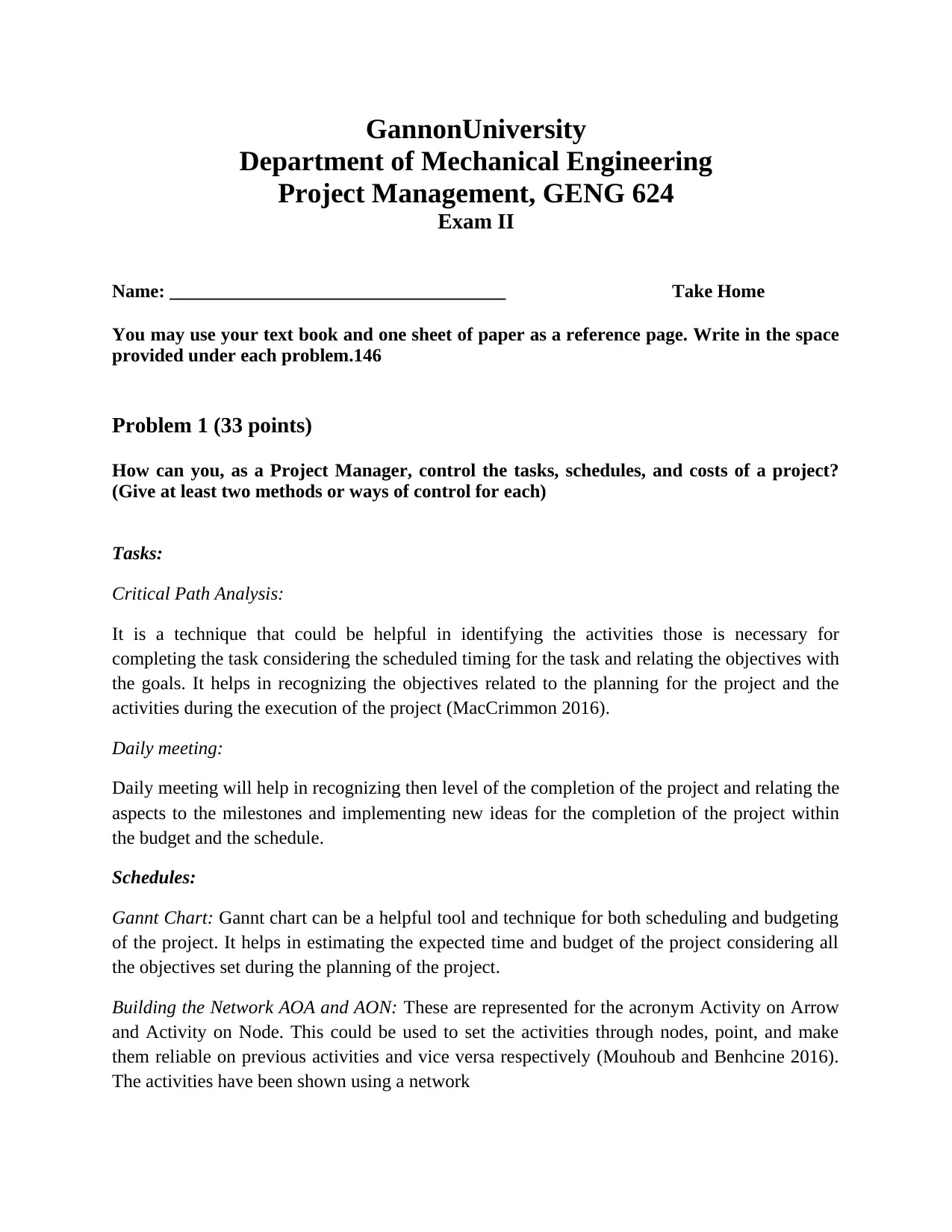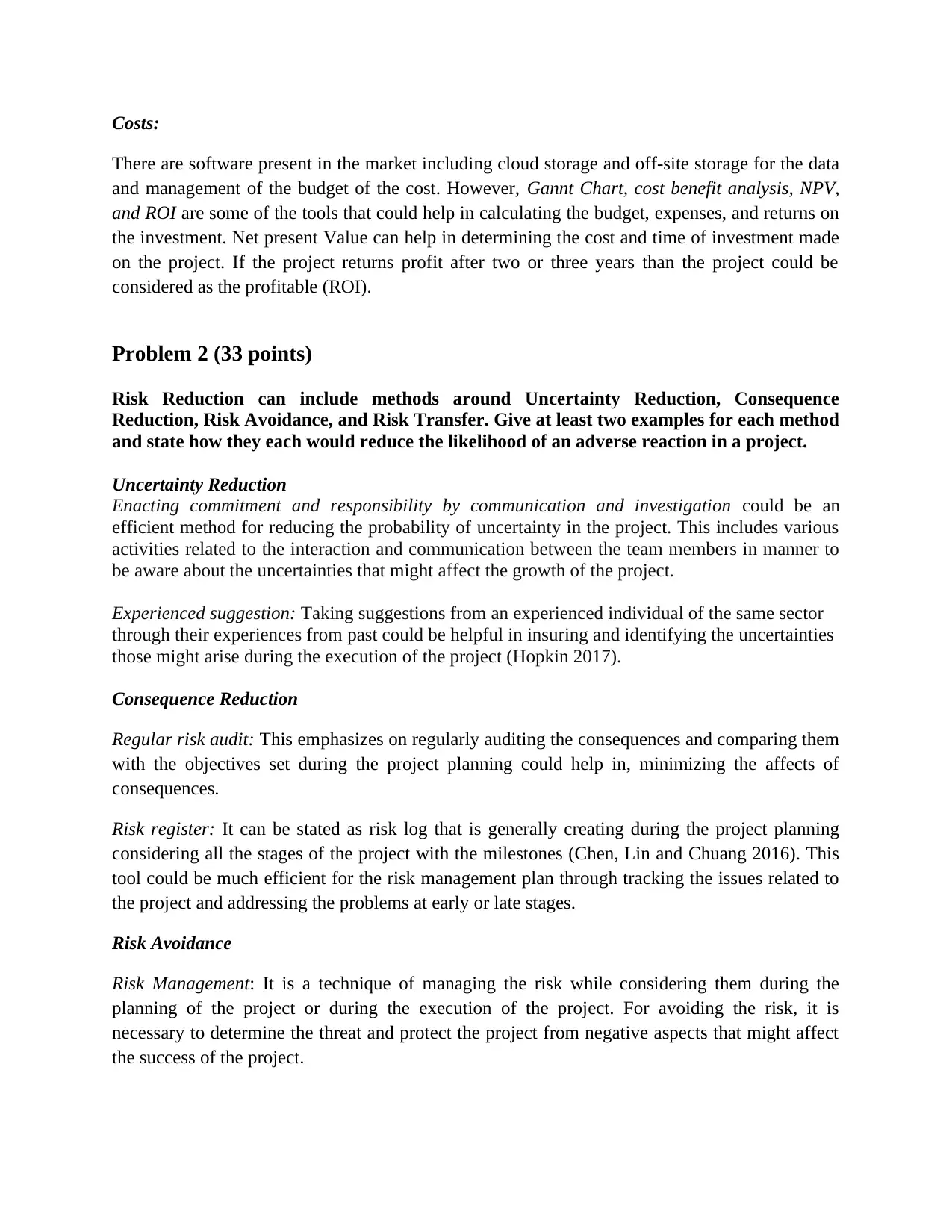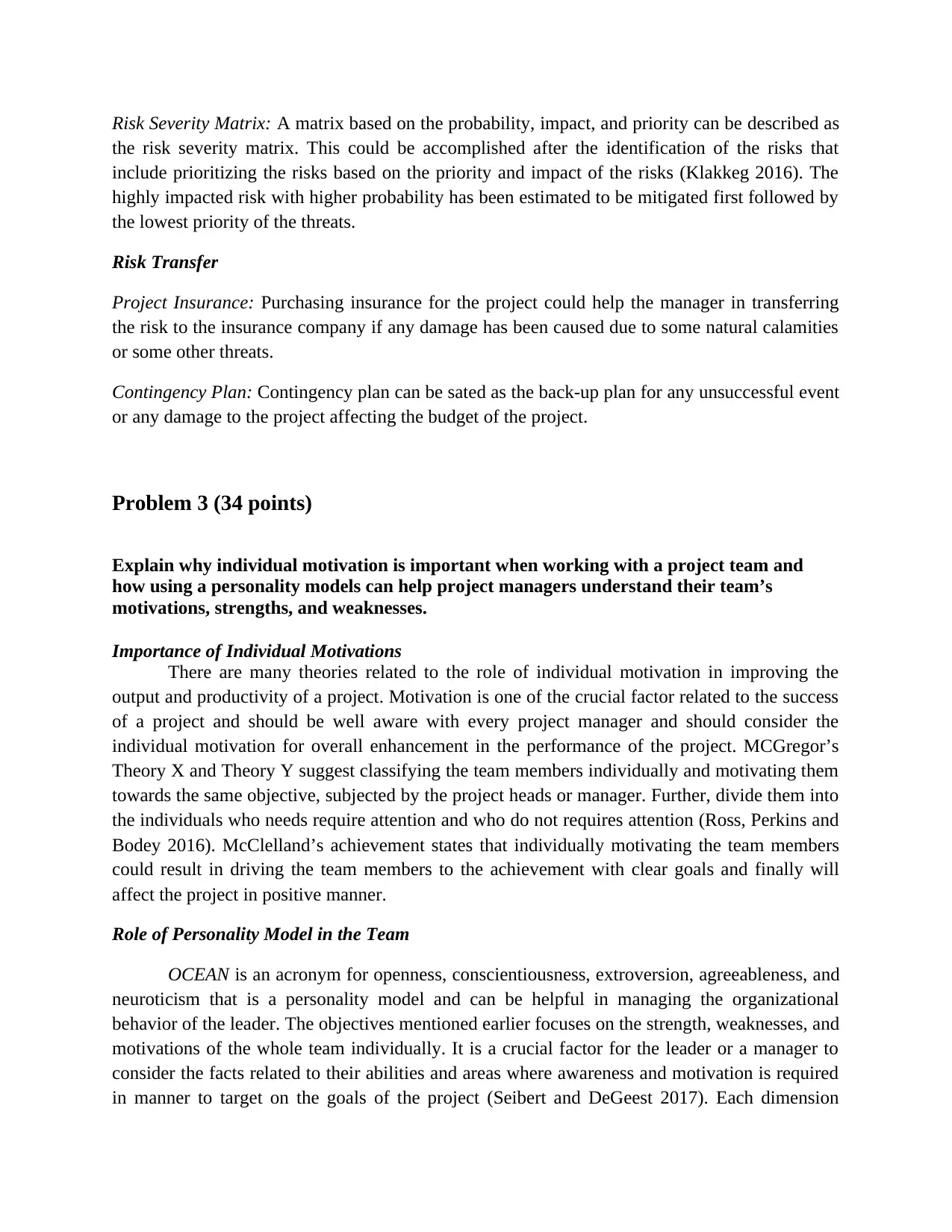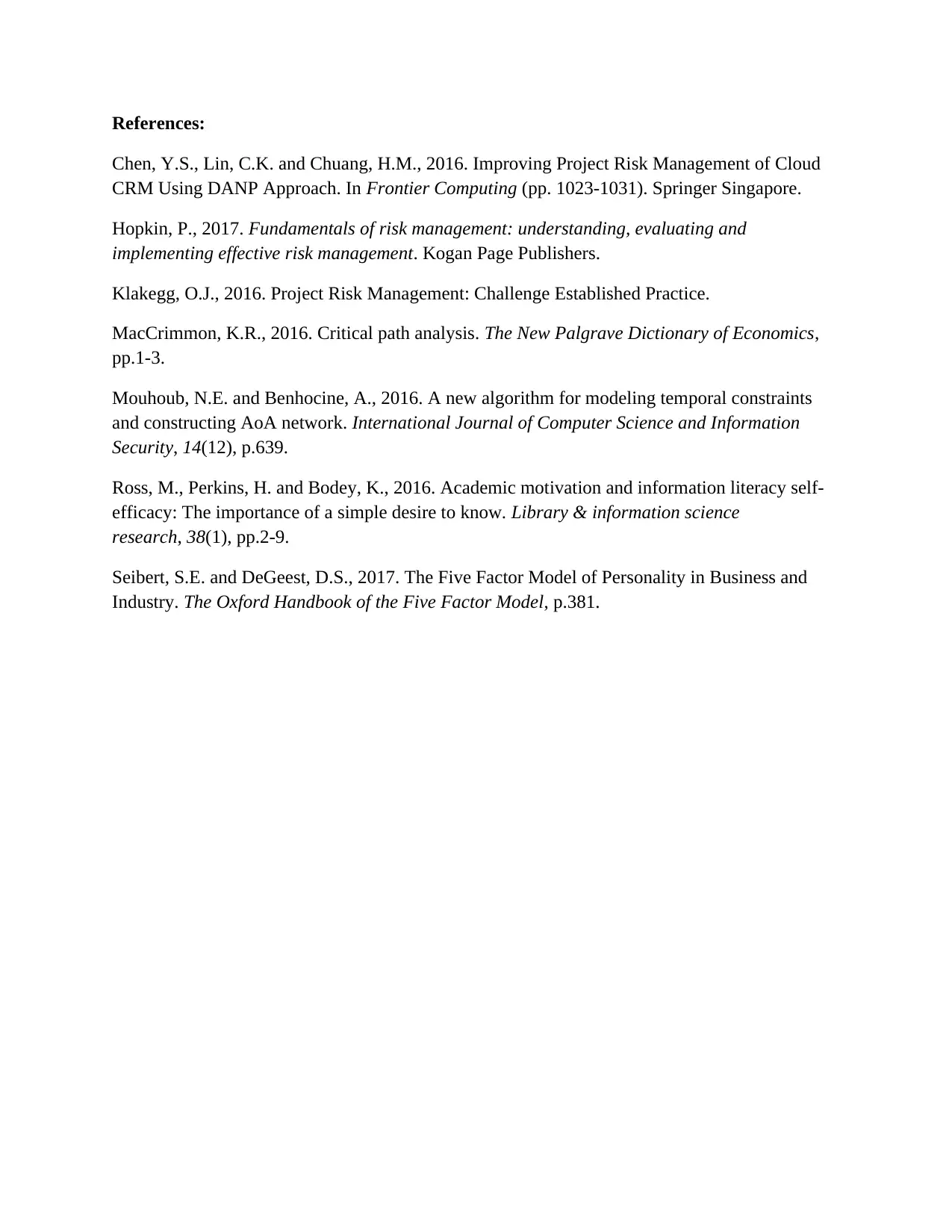Gannon University GENG 624 Exam II: Project Management Analysis
VerifiedAdded on 2020/04/21
|5
|1387
|211
Homework Assignment
AI Summary
This assignment solution addresses key aspects of project management, focusing on how project managers can control tasks, schedules, and costs through methods like Critical Path Analysis, Gantt charts, and cost-benefit analysis. It also explores risk reduction strategies, including uncertainty reduction, consequence reduction, risk avoidance, and risk transfer, providing practical examples for each. Furthermore, the solution emphasizes the importance of individual motivation within project teams and how personality models, such as the OCEAN model, can aid project managers in understanding team members' strengths, weaknesses, and motivations. The solution references several academic sources to support its claims and provides a comprehensive overview of project management principles. The assignment was part of GENG 624 course at Gannon University.

GannonUniversity
Department of Mechanical Engineering
Project Management, GENG 624
Exam II
Name: ____________________________________ Take Home
You may use your text book and one sheet of paper as a reference page. Write in the space
provided under each problem.146
Problem 1 (33 points)
How can you, as a Project Manager, control the tasks, schedules, and costs of a project?
(Give at least two methods or ways of control for each)
Tasks:
Critical Path Analysis:
It is a technique that could be helpful in identifying the activities those is necessary for
completing the task considering the scheduled timing for the task and relating the objectives with
the goals. It helps in recognizing the objectives related to the planning for the project and the
activities during the execution of the project (MacCrimmon 2016).
Daily meeting:
Daily meeting will help in recognizing then level of the completion of the project and relating the
aspects to the milestones and implementing new ideas for the completion of the project within
the budget and the schedule.
Schedules:
Gannt Chart: Gannt chart can be a helpful tool and technique for both scheduling and budgeting
of the project. It helps in estimating the expected time and budget of the project considering all
the objectives set during the planning of the project.
Building the Network AOA and AON: These are represented for the acronym Activity on Arrow
and Activity on Node. This could be used to set the activities through nodes, point, and make
them reliable on previous activities and vice versa respectively (Mouhoub and Benhcine 2016).
The activities have been shown using a network
Department of Mechanical Engineering
Project Management, GENG 624
Exam II
Name: ____________________________________ Take Home
You may use your text book and one sheet of paper as a reference page. Write in the space
provided under each problem.146
Problem 1 (33 points)
How can you, as a Project Manager, control the tasks, schedules, and costs of a project?
(Give at least two methods or ways of control for each)
Tasks:
Critical Path Analysis:
It is a technique that could be helpful in identifying the activities those is necessary for
completing the task considering the scheduled timing for the task and relating the objectives with
the goals. It helps in recognizing the objectives related to the planning for the project and the
activities during the execution of the project (MacCrimmon 2016).
Daily meeting:
Daily meeting will help in recognizing then level of the completion of the project and relating the
aspects to the milestones and implementing new ideas for the completion of the project within
the budget and the schedule.
Schedules:
Gannt Chart: Gannt chart can be a helpful tool and technique for both scheduling and budgeting
of the project. It helps in estimating the expected time and budget of the project considering all
the objectives set during the planning of the project.
Building the Network AOA and AON: These are represented for the acronym Activity on Arrow
and Activity on Node. This could be used to set the activities through nodes, point, and make
them reliable on previous activities and vice versa respectively (Mouhoub and Benhcine 2016).
The activities have been shown using a network
Paraphrase This Document
Need a fresh take? Get an instant paraphrase of this document with our AI Paraphraser

Costs:
There are software present in the market including cloud storage and off-site storage for the data
and management of the budget of the cost. However, Gannt Chart, cost benefit analysis, NPV,
and ROI are some of the tools that could help in calculating the budget, expenses, and returns on
the investment. Net present Value can help in determining the cost and time of investment made
on the project. If the project returns profit after two or three years than the project could be
considered as the profitable (ROI).
Problem 2 (33 points)
Risk Reduction can include methods around Uncertainty Reduction, Consequence
Reduction, Risk Avoidance, and Risk Transfer. Give at least two examples for each method
and state how they each would reduce the likelihood of an adverse reaction in a project.
Uncertainty Reduction
Enacting commitment and responsibility by communication and investigation could be an
efficient method for reducing the probability of uncertainty in the project. This includes various
activities related to the interaction and communication between the team members in manner to
be aware about the uncertainties that might affect the growth of the project.
Experienced suggestion: Taking suggestions from an experienced individual of the same sector
through their experiences from past could be helpful in insuring and identifying the uncertainties
those might arise during the execution of the project (Hopkin 2017).
Consequence Reduction
Regular risk audit: This emphasizes on regularly auditing the consequences and comparing them
with the objectives set during the project planning could help in, minimizing the affects of
consequences.
Risk register: It can be stated as risk log that is generally creating during the project planning
considering all the stages of the project with the milestones (Chen, Lin and Chuang 2016). This
tool could be much efficient for the risk management plan through tracking the issues related to
the project and addressing the problems at early or late stages.
Risk Avoidance
Risk Management: It is a technique of managing the risk while considering them during the
planning of the project or during the execution of the project. For avoiding the risk, it is
necessary to determine the threat and protect the project from negative aspects that might affect
the success of the project.
There are software present in the market including cloud storage and off-site storage for the data
and management of the budget of the cost. However, Gannt Chart, cost benefit analysis, NPV,
and ROI are some of the tools that could help in calculating the budget, expenses, and returns on
the investment. Net present Value can help in determining the cost and time of investment made
on the project. If the project returns profit after two or three years than the project could be
considered as the profitable (ROI).
Problem 2 (33 points)
Risk Reduction can include methods around Uncertainty Reduction, Consequence
Reduction, Risk Avoidance, and Risk Transfer. Give at least two examples for each method
and state how they each would reduce the likelihood of an adverse reaction in a project.
Uncertainty Reduction
Enacting commitment and responsibility by communication and investigation could be an
efficient method for reducing the probability of uncertainty in the project. This includes various
activities related to the interaction and communication between the team members in manner to
be aware about the uncertainties that might affect the growth of the project.
Experienced suggestion: Taking suggestions from an experienced individual of the same sector
through their experiences from past could be helpful in insuring and identifying the uncertainties
those might arise during the execution of the project (Hopkin 2017).
Consequence Reduction
Regular risk audit: This emphasizes on regularly auditing the consequences and comparing them
with the objectives set during the project planning could help in, minimizing the affects of
consequences.
Risk register: It can be stated as risk log that is generally creating during the project planning
considering all the stages of the project with the milestones (Chen, Lin and Chuang 2016). This
tool could be much efficient for the risk management plan through tracking the issues related to
the project and addressing the problems at early or late stages.
Risk Avoidance
Risk Management: It is a technique of managing the risk while considering them during the
planning of the project or during the execution of the project. For avoiding the risk, it is
necessary to determine the threat and protect the project from negative aspects that might affect
the success of the project.

Risk Severity Matrix: A matrix based on the probability, impact, and priority can be described as
the risk severity matrix. This could be accomplished after the identification of the risks that
include prioritizing the risks based on the priority and impact of the risks (Klakkeg 2016). The
highly impacted risk with higher probability has been estimated to be mitigated first followed by
the lowest priority of the threats.
Risk Transfer
Project Insurance: Purchasing insurance for the project could help the manager in transferring
the risk to the insurance company if any damage has been caused due to some natural calamities
or some other threats.
Contingency Plan: Contingency plan can be sated as the back-up plan for any unsuccessful event
or any damage to the project affecting the budget of the project.
Problem 3 (34 points)
Explain why individual motivation is important when working with a project team and
how using a personality models can help project managers understand their team’s
motivations, strengths, and weaknesses.
Importance of Individual Motivations
There are many theories related to the role of individual motivation in improving the
output and productivity of a project. Motivation is one of the crucial factor related to the success
of a project and should be well aware with every project manager and should consider the
individual motivation for overall enhancement in the performance of the project. MCGregor’s
Theory X and Theory Y suggest classifying the team members individually and motivating them
towards the same objective, subjected by the project heads or manager. Further, divide them into
the individuals who needs require attention and who do not requires attention (Ross, Perkins and
Bodey 2016). McClelland’s achievement states that individually motivating the team members
could result in driving the team members to the achievement with clear goals and finally will
affect the project in positive manner.
Role of Personality Model in the Team
OCEAN is an acronym for openness, conscientiousness, extroversion, agreeableness, and
neuroticism that is a personality model and can be helpful in managing the organizational
behavior of the leader. The objectives mentioned earlier focuses on the strength, weaknesses, and
motivations of the whole team individually. It is a crucial factor for the leader or a manager to
consider the facts related to their abilities and areas where awareness and motivation is required
in manner to target on the goals of the project (Seibert and DeGeest 2017). Each dimension
the risk severity matrix. This could be accomplished after the identification of the risks that
include prioritizing the risks based on the priority and impact of the risks (Klakkeg 2016). The
highly impacted risk with higher probability has been estimated to be mitigated first followed by
the lowest priority of the threats.
Risk Transfer
Project Insurance: Purchasing insurance for the project could help the manager in transferring
the risk to the insurance company if any damage has been caused due to some natural calamities
or some other threats.
Contingency Plan: Contingency plan can be sated as the back-up plan for any unsuccessful event
or any damage to the project affecting the budget of the project.
Problem 3 (34 points)
Explain why individual motivation is important when working with a project team and
how using a personality models can help project managers understand their team’s
motivations, strengths, and weaknesses.
Importance of Individual Motivations
There are many theories related to the role of individual motivation in improving the
output and productivity of a project. Motivation is one of the crucial factor related to the success
of a project and should be well aware with every project manager and should consider the
individual motivation for overall enhancement in the performance of the project. MCGregor’s
Theory X and Theory Y suggest classifying the team members individually and motivating them
towards the same objective, subjected by the project heads or manager. Further, divide them into
the individuals who needs require attention and who do not requires attention (Ross, Perkins and
Bodey 2016). McClelland’s achievement states that individually motivating the team members
could result in driving the team members to the achievement with clear goals and finally will
affect the project in positive manner.
Role of Personality Model in the Team
OCEAN is an acronym for openness, conscientiousness, extroversion, agreeableness, and
neuroticism that is a personality model and can be helpful in managing the organizational
behavior of the leader. The objectives mentioned earlier focuses on the strength, weaknesses, and
motivations of the whole team individually. It is a crucial factor for the leader or a manager to
consider the facts related to their abilities and areas where awareness and motivation is required
in manner to target on the goals of the project (Seibert and DeGeest 2017). Each dimension
⊘ This is a preview!⊘
Do you want full access?
Subscribe today to unlock all pages.

Trusted by 1+ million students worldwide

describes about the way of establishing each individuals in different categories. People at the
middle of the dimension can easily be pushed to either side of the dimension.
middle of the dimension can easily be pushed to either side of the dimension.
Paraphrase This Document
Need a fresh take? Get an instant paraphrase of this document with our AI Paraphraser

References:
Chen, Y.S., Lin, C.K. and Chuang, H.M., 2016. Improving Project Risk Management of Cloud
CRM Using DANP Approach. In Frontier Computing (pp. 1023-1031). Springer Singapore.
Hopkin, P., 2017. Fundamentals of risk management: understanding, evaluating and
implementing effective risk management. Kogan Page Publishers.
Klakegg, O.J., 2016. Project Risk Management: Challenge Established Practice.
MacCrimmon, K.R., 2016. Critical path analysis. The New Palgrave Dictionary of Economics,
pp.1-3.
Mouhoub, N.E. and Benhocine, A., 2016. A new algorithm for modeling temporal constraints
and constructing AoA network. International Journal of Computer Science and Information
Security, 14(12), p.639.
Ross, M., Perkins, H. and Bodey, K., 2016. Academic motivation and information literacy self-
efficacy: The importance of a simple desire to know. Library & information science
research, 38(1), pp.2-9.
Seibert, S.E. and DeGeest, D.S., 2017. The Five Factor Model of Personality in Business and
Industry. The Oxford Handbook of the Five Factor Model, p.381.
Chen, Y.S., Lin, C.K. and Chuang, H.M., 2016. Improving Project Risk Management of Cloud
CRM Using DANP Approach. In Frontier Computing (pp. 1023-1031). Springer Singapore.
Hopkin, P., 2017. Fundamentals of risk management: understanding, evaluating and
implementing effective risk management. Kogan Page Publishers.
Klakegg, O.J., 2016. Project Risk Management: Challenge Established Practice.
MacCrimmon, K.R., 2016. Critical path analysis. The New Palgrave Dictionary of Economics,
pp.1-3.
Mouhoub, N.E. and Benhocine, A., 2016. A new algorithm for modeling temporal constraints
and constructing AoA network. International Journal of Computer Science and Information
Security, 14(12), p.639.
Ross, M., Perkins, H. and Bodey, K., 2016. Academic motivation and information literacy self-
efficacy: The importance of a simple desire to know. Library & information science
research, 38(1), pp.2-9.
Seibert, S.E. and DeGeest, D.S., 2017. The Five Factor Model of Personality in Business and
Industry. The Oxford Handbook of the Five Factor Model, p.381.
1 out of 5
Related Documents
Your All-in-One AI-Powered Toolkit for Academic Success.
+13062052269
info@desklib.com
Available 24*7 on WhatsApp / Email
![[object Object]](/_next/static/media/star-bottom.7253800d.svg)
Unlock your academic potential
Copyright © 2020–2025 A2Z Services. All Rights Reserved. Developed and managed by ZUCOL.




